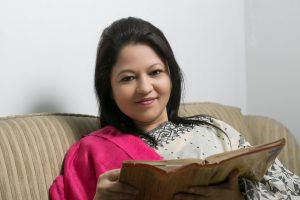Older women in Southeast Asia have been learning to use technology to spread positivity during the COVID-19 pandemic. This article describes how older women have reached new target audiences and revived lost passions while learning to use technology in a society where women do not generally have such opportunities. Their actions have highlighted the role technology can play in creating opportunities for female empowerment while still upholding collectivist values.
The risk factors of aging and social distancing during the COVID-19 pandemic have made older adults, particularly older women, more vulnerable to stress and anxiety. Notably, older women have been more affected by isolation and distress independent of health factors. However, culture and customs can significantly affect people’s coping mechanisms. In the Southeast Asian context, the collectivist culture and technology usage are substantially different from most Western countries. Our research on older women in urban Southeast Asia revealed how they have been using technology to build resilience by engaging in creative exercise and promoting positivity during the pandemic.

Figure 1. A statue of the goddess Durga. (“Durga idol as Migrant mother DSCN7274,” Sumita Roy Dutta, CC BY-SA 4.0, via Wikimedia Commons.)
Although Southeast Asia’s societal structure keeps women from enjoying equal opportunities in education, employment, and decision-making, these women actively fight for their families during times of hardship. This is apparent in how many Southeast Asian cultures romanticize and celebrate women as saviors who show their strength during times of distress. For example, Figure 1 shows a depiction of the goddess Durga as a migrant mother who is guiding and protecting her children.
This past year, Southeast Asian women again emerged as warriors. Despite the high-risk age factor and increased distress related to social isolation and misinformation, older women from this region exhibited unique coping strategies. In a study of 18 middle-class, older women (aged 60 to 65) from six Southeast Asian countries (India, 7; Bangladesh, 6; Pakistan, 2; Afghanistan, 1; Maldives, 1; and Sri Lanka, 1), we explored how they employed positivity and technology to cope with the uncertainty that has resulted from the COVID-19 pandemic.
Gender and Access to Technology
Despite the fundamental changes in the social, economic, and political structures of Southeast Asian countries over the past three or four decades, many aspects of the extended family culture remain. Women, especially older women, still face challenges related to social roles and status, gender disparities, patriarchal kinship, and financial dependencies in relationships. The differences in education, employment levels, and the dependency on their husbands and sons result in limited freedom of movement, limited opportunities to make household decisions, little control over economic resources, and minimal inheritance rights. Moreover, they often stay within the bounds of strict patriarchal rules and regulations inside their families.
A rich body of research on information and communication technology (ICT) for development in Southeast Asia has highlighted gender discrimination as a significant obstacle for development within this region. In a tech-oriented world, the disparities in technology literacy, access, and abilities affect all women in this region, irrespective of their age and social status. The women in our study tried to overcome the technology divide for the sake of their loved ones’ well-being.
Study Overview
We conducted an exploratory study to gain an understanding of how older women in this region coped with the uncertainty related to the COVID-19 pandemic. The study was conducted over two months, from May 2020 to June 2020, during an ongoing lockdown in these Southeast Asian countries. We connected to the participants through personal, academic, and professional contacts. The criteria for participation included that the women came from urban, middle-income families; had access to digital technology; and were willing and comfortable to share their experiences with us. The online research interviews were conducted in Bengali, Hindi, and English and lasted between one and three hours.
Exploring Technology during the COVID-19 Pandemic
The women in this study were not necessarily very experienced in using technology before the pandemic. Regardless of their educational or professional backgrounds, these women exhibited efforts to spread positivity toward the community during the pandemic. Some were homemakers, while others were teachers, businesswomen, or social workers. Their enthusiasm for sharing experience and knowledge, connecting with distant and rural relatives and friends through Skype, Zoom, Google Meetup, and different social media was visible regardless of their location or background. Many of them learned to use these technologies for the first time to reach out to their loved ones, fostering resilience, creativity, and positivity within their online network and hosting creative online events to make their loved ones feel less distressed. The following section contains examples and quotes from some of the women who participated in our study.
Using Technology to Spread Positivity
Gultekin Khan, a poet and retired school teacher from Bangladesh, described how she tried to spread a positive vibe among her Facebook friends during the social isolation period. Her experience with social networking sites and online networks gave her the motivation to reach out to her friends and family and create positivity when everyone else appeared to be depressed.
“As I write poems, I am trying to write poems with positivity in this period. I usually wrote one poem in two/three months, but during the lockdown, I wrote three or four poems in a month. When I write these poems, I post them on Facebook for my friends.”
—Gultekin Khan

Figure 2. Gultekin Khan (Bangladesh), reciting a poem for the researchers that she wrote during COVID-19.
Asita Bhadra, an older mother and homemaker from India, used to perform in stage dramas long before she got married. During the COVID-19 isolation period, she participated in an online audio drama competition for the first time in 50 years. Figure 3 shows her rehearsing for an online drama session and with the prize she won in a Facebook group’s drama competition. She explained that her interaction with technology inspired her to nurture her long-lost dream of performing in cultural shows.
“Now, I do sufi natok [religious drama]. I am involved with different groups – robi nazrul loko giti [folk drama]. I have rehearsal every day without Monday Tuesday in Facebook groups.”
—Asita Bhadra

Figure 3. Asita Bhadra during rehearsal (left) and with a prize she won (right).
There were also stories of redesigning a teaching curriculum, modeling new business approaches, and organizing new models of social activities using various online platforms.
For example, Kamla Bhasin, a social worker from India, described the bright side of organizing online social activities and mentioned feeling more empowered and inclusive as she was able to reach a more diverse audience by using technology.
“Now I am doing all online workshops and webinars. In webinars, previously we had 200 audiences; now, thousands join. Previously, If I did a seminar, only 40 to 50 people would come. There was no sharing of talk in most of the cases. Today I gave a talk on Facebook Live for the first time in Punjabi [an Indian language]. Within 4.5 hours, 400 people watched, and 100 of them shared it. Now thousands of people are sharing it on Facebook.”
—Kamla Bhasin
Another example of a woman exploring the idea of reaching a more diverse audience is that of Lubna Marium. She has a dance school in Dhaka, the capital of Bangladesh, and her students are mostly from well-off families living in the city. During the pandemic, she explored the opportunity of including a more diverse population in her dance classes through the use of video conferences. During our study, she was preparing a distance learning curriculum and connecting with indigenous people. She shared her plans for redesigning her dance curriculum using Zoom so that indigenous people who live far from her can join her classes.
Leelaboti (pseudonym), a businesswoman from Bangladesh, remodeled her business structure so that her employees could work remotely throughout the social isolation period.
Finally, Asma (pseudonym), a retired teacher from Pakistan, became worried when she saw how social isolation was impacting people’s mental health. She then attended an online short course on self-growth and mental health, which taught her the importance of improving mental health. She used this newly acquired knowledge and motivation to start helping those around her.
Enthusiasm and Social Structure
Different cultural and traditional practices, social distancing, and social isolation due to the pandemic have had various negative effects on people’s day-to-day lives. Unlike Western countries, people from Southeast Asia are more collectivistic, have more social networks, and engage in several religious festivals and get-togethers during a typical year. This collectivist culture helps people cope with uncertainty. While many older people around the world are experiencing distress as a result of rugged individualism and alienation during the pandemic, the older women from our study reported high motivation and enthusiasm to learn and use technology when asked about concerns of adversity in their communities.
Technology Design toward Feminism
The technology interaction of older women from Southeast Asia inevitably ties in with the concept of social activism, especially within systems of patriarchy, collectivist cultural norms, and taboos. Although the naive vision of activism for empowering women is often portrayed as a distinct and separate wave that includes young women only, including older women within the digital space can eventually pave the path for empowering younger women—almost as a ripple effect. Designing and focusing on the interaction experience of Southeast Asia’s older women with equal rigor can help to lessen the gender gap and provide agency. It can make not only these older women feel empowered but also the generations after them while still upholding collectivist values.
Known by the Storm
Gultekin Khan, Poet, Bangladesh
(Posted for her Facebook friends)
Let the girl open her eyes.
She can still engulf the
Fiery seas and simoom
With her bare hands.
She can devour the skies
While standing on her feet.
Stay with the girl.
Only the cyclone knows
What power she hides
In her little fingers.
Let her go forward.
She has a comet in her hair,
Her eyes encompass the land and the hills,
Merit adorns her palms.
She will claim victory for us all.
(Translated by Vishak Devratnam)


